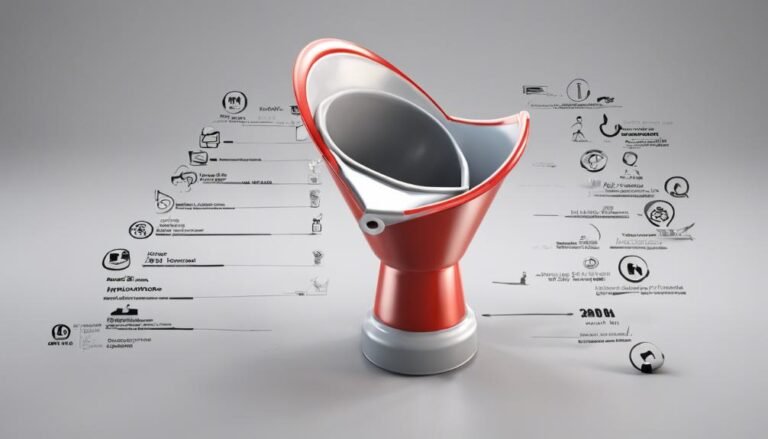How to Build a Mobile App for Your Business
To build a mobile app for your business, start by researching your market and competitors. Define your app's goals and features based on user feedback. Choose a development approach by comparing frameworks for cost and scalability. Create wireframes and prioritize user-friendly design. Develop intuitive UI/UX with consistent branding elements. Systematically test your app through development stages. Submit your app to app stores following guidelines. Market your app post-launch for visibility and user engagement. Mastering these steps is crucial for engaging your audience effectively in the modern digital age. Apply these strategies to guarantee success in your app development journey.
Key Takeaways
- Conduct market research to identify user needs and preferences.
- Choose a scalable development framework like React Native or Flutter.
- Develop for both iOS and Android platforms for wider reach.
- Design intuitive UI/UX with consistent branding elements.
- Implement a post-launch marketing strategy for app visibility.
Market Research
Before developing a mobile app for your business, conduct thorough market research to guarantee it meets the needs and expectations of your target audience. Start by exploring competitor analysis to understand what similar apps offer and how you can differentiate yours. By identifying your competitors' strengths and weaknesses, you can leverage opportunities they may have missed.
Next, dig into target audience analysis to pinpoint who your app is for. Understand their demographics, preferences, and pain points to tailor your app to their specific needs. By knowing your audience inside and out, you can design a user-centric app that resonates with them.
Analyzing your competitors and target audience will provide valuable insights that will shape the direction of your mobile app. This detailed approach ensures that your app isn't only innovative but also meets the demands of your users, setting you up for success in the competitive app market.
Define Goals and Features
Conducting thorough market research has equipped you with valuable insights; now, it's time to define the goals and features of your mobile app to align with your target audience's needs and expectations.
To achieve this, consider the following steps:
- Identifying Needs: Start by clearly outlining what problems your app will solve for your users. Understanding their pain points will help you prioritize features that are essential for enhancing user experience.
- Incorporating Feedback: Gather feedback from potential users, stakeholders, and beta testers to refine your app's goals and features. Their input can provide valuable insights into what resonates with your audience.
- Setting Clear Goals: Define specific, measurable objectives for your app. Whether it's increasing user engagement, driving sales, or improving customer satisfaction, setting clear goals will guide your feature development process.
- User-Centric Design: Make sure that every feature you incorporate serves a purpose for the end-user. Prioritize simplicity, intuitiveness, and accessibility to create a seamless user experience that meets their needs effectively.
Choose Development Approach
When building your mobile app, selecting the right app framework and deciding on the platform are essential steps.
Choosing the appropriate app framework will impact the development process and the app's performance.
Deciding on the platform will determine the reach and accessibility of your app to users.
Selecting App Framework
To determine the most suitable app framework for your business needs, consider evaluating various development approaches based on their compatibility with your objectives and technical requirements.
- App Framework Comparison: Compare different frameworks such as React Native, Flutter, or Xamarin to see which aligns best with your app requirements and team expertise.
- Development Cost Analysis: Conduct a thorough analysis of the costs associated with each framework, including licensing fees, development time, and ongoing maintenance expenses.
- User Experience Considerations: Prioritize frameworks that offer tools for creating a seamless and intuitive user experience, ensuring customer satisfaction and retention.
- Scalability Planning: Choose a framework that allows for easy scalability as your business grows, ensuring that your app can handle increased user loads and feature expansions efficiently.
Deciding on Platform
Compare the advantages and limitations of developing your mobile app for either iOS, Android, or both platforms to determine the most suitable platform for your business. When deciding on a platform, consider factors like cross-platform compatibility, user experience, long-term scalability, and your target audience.
If you choose to develop for iOS, you may benefit from higher user engagement and spending, especially if your target audience is more inclined towards Apple products. However, Android offers a larger user base, making it ideal for reaching a wider audience. Developing for both platforms ensures maximum market reach but can be more time-consuming and costly.
Cross-platform compatibility is essential for ensuring your app works seamlessly across different devices. Focus on providing a consistent and intuitive user experience to keep your audience engaged. Additionally, consider the long-term scalability of your chosen platform to accommodate future updates and growth.
Wireframing and Prototyping
When building a mobile app for your business, it's important to start with wireframing and prototyping. Visualizing the app layout and testing user interactions early on can help you refine your ideas and establish a user-centric design.
Visualize App Layout
Start by creating a wireframe to visually map out the basic structure and layout of your mobile app before moving on to prototyping its functionalities.
When visualizing your app layout, consider the color scheme to evoke the right emotions and guarantee a cohesive design. Smooth navigation flow is vital for a seamless user experience.
Here are some key points to focus on:
- User-Centric Design: Prioritize the user journey and make sure that the app layout is intuitive and easy to navigate.
- Branding Consistency: Maintain consistency with your brand's visual elements such as logos, fonts, and colors to enhance recognition and trust.
- Interactive Elements: Incorporate interactive features to enhance user engagement and create a dynamic user experience.
- Feedback Integration: Include mechanisms for user feedback to continuously improve the app layout and functionality based on user preferences and behaviors.
Test User Interactions
To guarantee a high-quality user experience and functionality, test user interactions by implementing wireframing and prototyping techniques in the development of your mobile app.
Wireframing allows you to create a visual guide that outlines the structure and flow of your app, helping you to understand how users will navigate through it. By incorporating user feedback during the wireframing stage, you can make necessary adjustments to enhance the overall user experience.
Prototyping takes the wireframe a step further by creating an interactive model of your app. This allows for realistic user testing where individuals can engage with the app and provide valuable insights for improvements.
User engagement during the prototyping phase is essential as it helps in identifying any usability issues and fine-tuning the app for best performance. By actively involving users in the testing process, you can make sure that your mobile app meets their expectations and provides a seamless experience.
UI/UX Design
Crafting a seamless and intuitive user experience (UX) through thoughtful user interface (UI) design is crucial when developing a mobile app for your business.
To guarantee your app resonates with users and stays relevant in a rapidly evolving digital landscape, consider the following key points:
- User-Centric Approach: Prioritize user engagement by designing your app with the end-user in mind. Conduct user research to understand their needs and preferences, and tailor the UI/UX accordingly.
- Sleek and Minimalistic Design: Embrace current design trends such as minimalism and clean aesthetics to create a visually appealing app that's easy to navigate. Avoid clutter and focus on simplicity.
- Intuitive Navigation: Implement intuitive navigation patterns like bottom tabs or gesture-based controls to enhance usability. Users should be able to navigate the app effortlessly without feeling overwhelmed.
- Consistent Branding: Maintain consistency in branding elements such as colors, typography, and imagery throughout the app. A cohesive brand identity helps establish trust and recognition among users.
Development and Testing
Embrace a systematic approach to developing and testing your mobile app to guarantee peak functionality and user satisfaction. Begin by conducting beta testing to gather valuable user feedback. This stage allows you to identify any bugs or issues that may impact the app's performance. Promptly address these through thorough bug fixing to guarantee a smooth user experience.
User feedback is an essential aspect of the development process. Actively seek input from a diverse group of users to understand their needs and preferences. This information is invaluable for optimizing the app and enhancing its usability. Implement changes based on this feedback to tailor the app to the users' requirements.
Optimization is key to delivering a high-quality mobile app. Continuously refine and enhance the app's features to provide a seamless and enjoyable user experience. By prioritizing user-centric design and consistently seeking user feedback, you can create a mobile app that not only meets but exceeds user expectations.
App Store Submission
Begin by preparing your mobile app for submission to the app store by ensuring it meets all the necessary guidelines and requirements for a successful launch.
To navigate the app store submission process effectively, follow these key steps:
- Adhere to App Store Guidelines: Thoroughly review the guidelines provided by the app store you're submitting to. Guarantee your app complies with their policies regarding content, design, and functionality.
- Test Your App Rigorously: Before submission, conduct in-depth testing to identify and fix any bugs or issues. This step is essential to providing users with a seamless experience.
- Prepare App Assets: Gather all necessary assets such as app icons, screenshots, descriptions, and marketing materials. These elements are crucial for attracting users to download your app.
- Create a Developer Account: Register for a developer account on the app store platform. This account will allow you to submit your app for review and manage its presence on the store.
Post-Launch Marketing
Implementing a thorough post-launch marketing strategy is essential to maximize the visibility and success of your mobile app in the competitive digital marketplace. Once your app is live, leverage social media platforms to engage with your audience, share updates, and gather feedback.
Utilize social media ads to target specific demographics and drive app downloads. Collaborating with influencers can also greatly enhance your app's visibility. Partner with influencers whose audience aligns with your target market to create authentic content that promotes your app. Influencer partnerships can help increase brand awareness and credibility.
Engage with your users through social media channels by responding to comments, addressing concerns, and providing valuable content. Encourage users to share their experiences with your app on social media, creating a buzz around your product. Additionally, consider running contests or giveaways on social platforms to generate excitement and attract new users.
Conclusion
Congratulations on taking the first step towards building a mobile app for your business!
Just like a skilled architect carefully designs a blueprint for a magnificent skyscraper, you have laid the foundation for success with your app development journey.
Remember, every detail matters and every decision you make will impact the final product. Stay focused, stay innovative, and always keep your users at the forefront of your mind.
Good luck on your app-building adventure!








